Managerial Accounting Report: ABB and Trust Company Limited
VerifiedAdded on 2023/06/07
|13
|3861
|337
Report
AI Summary
This report analyzes the application of Activity-Based Budgeting (ABB) to Trust Company Limited, a financial services company in Australia. The report begins with an executive summary, followed by an introduction highlighting the importance of budgeting and the advantages of ABB over traditional methods. It then describes Trust Company Limited and explains the features of ABB, emphasizing its link to organizational objectives, resource allocation based on cost drivers, and focus on actual outcomes. The report contrasts ABB with traditional budgeting systems, detailing the key differences in resource allocation, cost analysis, and the identification of non-value costs. The analysis concludes that ABB is a suitable system for Trust Company Limited due to its results-based approach, ability to accurately examine responsibility for all activity levels, and improved efficiency in resource allocation, making it beneficial for the company's financial planning and operations.

Managerial Accounting 1
MANAGERIAL ACCOUNTING
Author
Course
Professor
City
Date
MANAGERIAL ACCOUNTING
Author
Course
Professor
City
Date
Paraphrase This Document
Need a fresh take? Get an instant paraphrase of this document with our AI Paraphraser
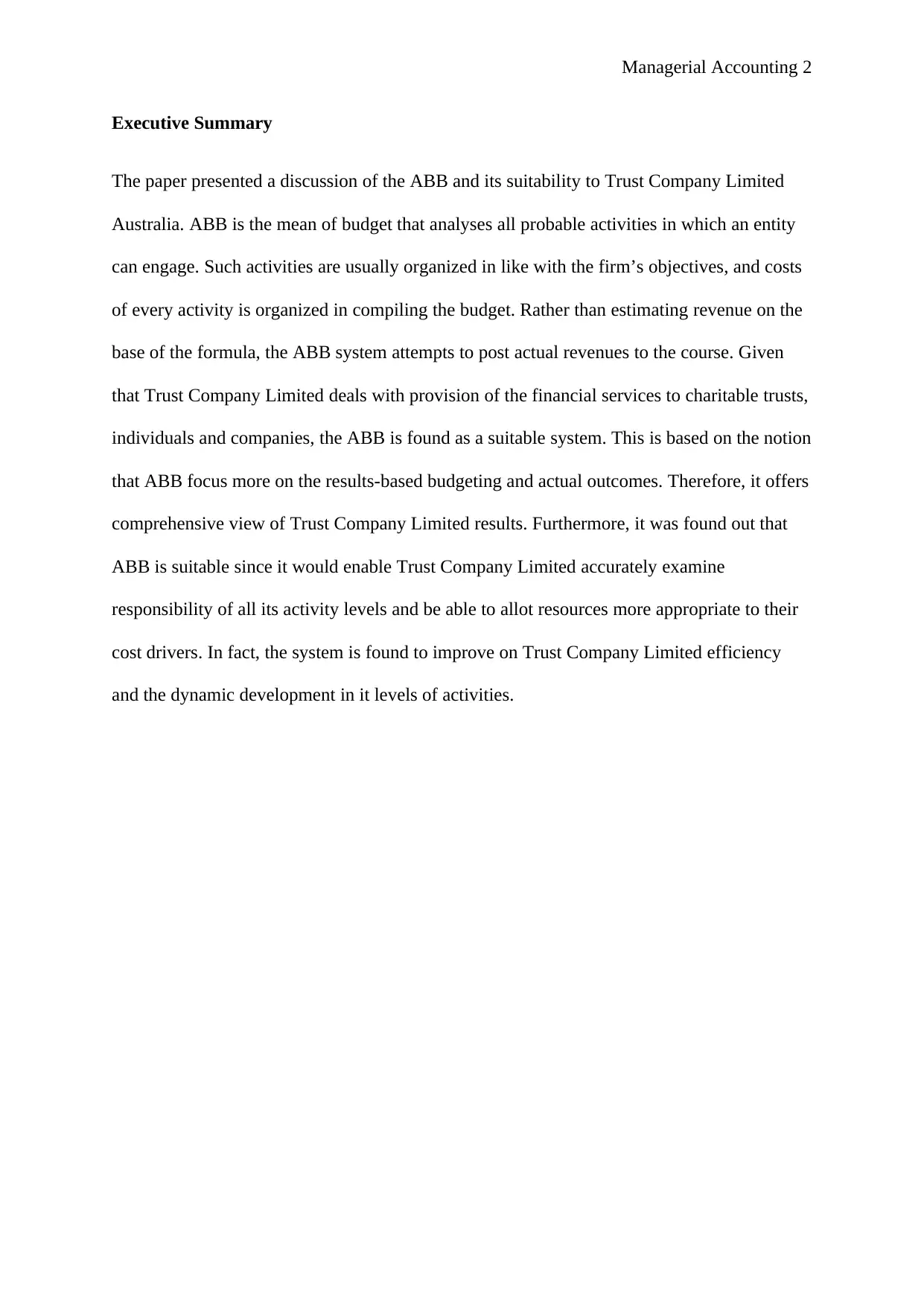
Managerial Accounting 2
Executive Summary
The paper presented a discussion of the ABB and its suitability to Trust Company Limited
Australia. ABB is the mean of budget that analyses all probable activities in which an entity
can engage. Such activities are usually organized in like with the firm’s objectives, and costs
of every activity is organized in compiling the budget. Rather than estimating revenue on the
base of the formula, the ABB system attempts to post actual revenues to the course. Given
that Trust Company Limited deals with provision of the financial services to charitable trusts,
individuals and companies, the ABB is found as a suitable system. This is based on the notion
that ABB focus more on the results-based budgeting and actual outcomes. Therefore, it offers
comprehensive view of Trust Company Limited results. Furthermore, it was found out that
ABB is suitable since it would enable Trust Company Limited accurately examine
responsibility of all its activity levels and be able to allot resources more appropriate to their
cost drivers. In fact, the system is found to improve on Trust Company Limited efficiency
and the dynamic development in it levels of activities.
Executive Summary
The paper presented a discussion of the ABB and its suitability to Trust Company Limited
Australia. ABB is the mean of budget that analyses all probable activities in which an entity
can engage. Such activities are usually organized in like with the firm’s objectives, and costs
of every activity is organized in compiling the budget. Rather than estimating revenue on the
base of the formula, the ABB system attempts to post actual revenues to the course. Given
that Trust Company Limited deals with provision of the financial services to charitable trusts,
individuals and companies, the ABB is found as a suitable system. This is based on the notion
that ABB focus more on the results-based budgeting and actual outcomes. Therefore, it offers
comprehensive view of Trust Company Limited results. Furthermore, it was found out that
ABB is suitable since it would enable Trust Company Limited accurately examine
responsibility of all its activity levels and be able to allot resources more appropriate to their
cost drivers. In fact, the system is found to improve on Trust Company Limited efficiency
and the dynamic development in it levels of activities.
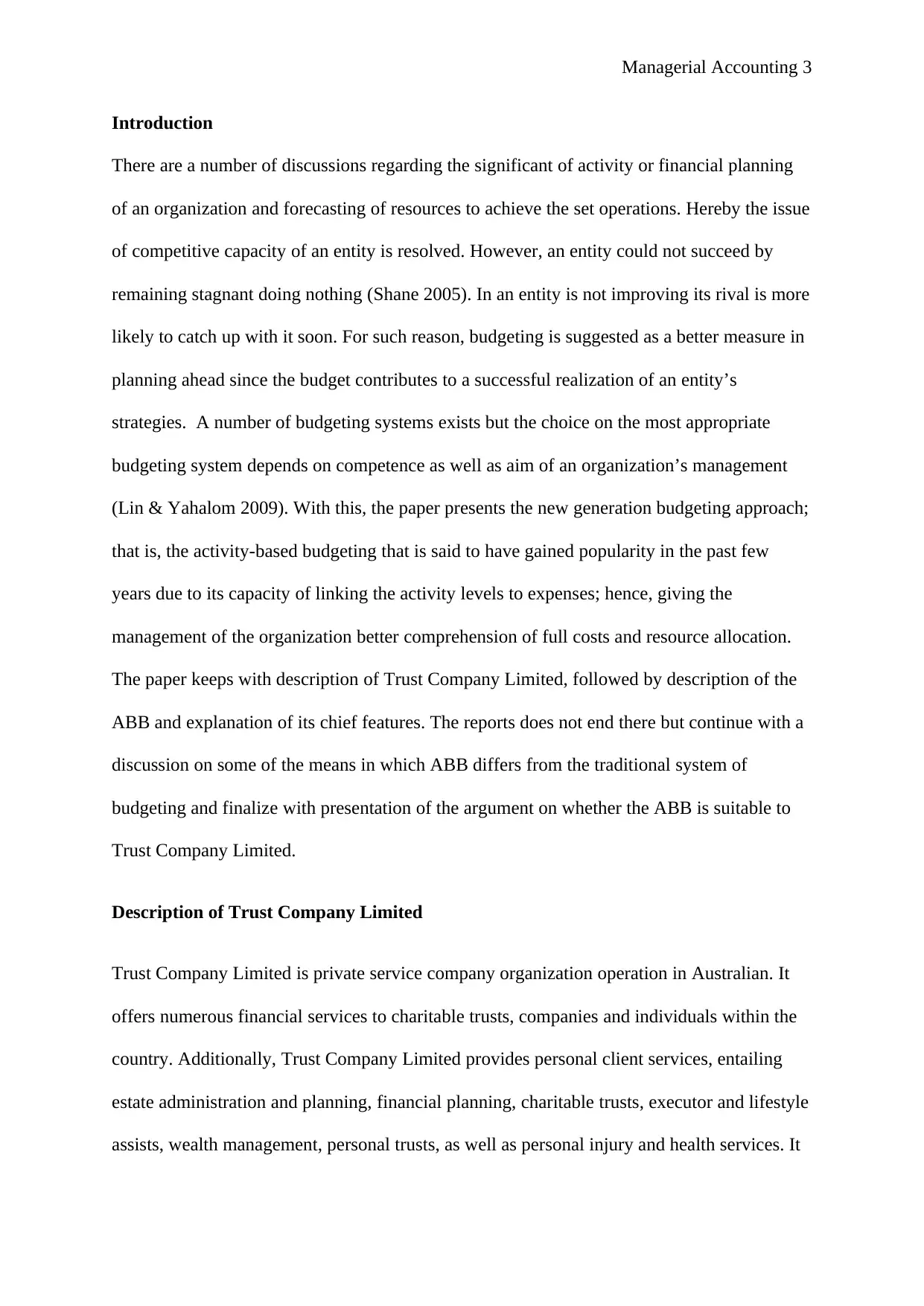
Managerial Accounting 3
Introduction
There are a number of discussions regarding the significant of activity or financial planning
of an organization and forecasting of resources to achieve the set operations. Hereby the issue
of competitive capacity of an entity is resolved. However, an entity could not succeed by
remaining stagnant doing nothing (Shane 2005). In an entity is not improving its rival is more
likely to catch up with it soon. For such reason, budgeting is suggested as a better measure in
planning ahead since the budget contributes to a successful realization of an entity’s
strategies. A number of budgeting systems exists but the choice on the most appropriate
budgeting system depends on competence as well as aim of an organization’s management
(Lin & Yahalom 2009). With this, the paper presents the new generation budgeting approach;
that is, the activity-based budgeting that is said to have gained popularity in the past few
years due to its capacity of linking the activity levels to expenses; hence, giving the
management of the organization better comprehension of full costs and resource allocation.
The paper keeps with description of Trust Company Limited, followed by description of the
ABB and explanation of its chief features. The reports does not end there but continue with a
discussion on some of the means in which ABB differs from the traditional system of
budgeting and finalize with presentation of the argument on whether the ABB is suitable to
Trust Company Limited.
Description of Trust Company Limited
Trust Company Limited is private service company organization operation in Australian. It
offers numerous financial services to charitable trusts, companies and individuals within the
country. Additionally, Trust Company Limited provides personal client services, entailing
estate administration and planning, financial planning, charitable trusts, executor and lifestyle
assists, wealth management, personal trusts, as well as personal injury and health services. It
Introduction
There are a number of discussions regarding the significant of activity or financial planning
of an organization and forecasting of resources to achieve the set operations. Hereby the issue
of competitive capacity of an entity is resolved. However, an entity could not succeed by
remaining stagnant doing nothing (Shane 2005). In an entity is not improving its rival is more
likely to catch up with it soon. For such reason, budgeting is suggested as a better measure in
planning ahead since the budget contributes to a successful realization of an entity’s
strategies. A number of budgeting systems exists but the choice on the most appropriate
budgeting system depends on competence as well as aim of an organization’s management
(Lin & Yahalom 2009). With this, the paper presents the new generation budgeting approach;
that is, the activity-based budgeting that is said to have gained popularity in the past few
years due to its capacity of linking the activity levels to expenses; hence, giving the
management of the organization better comprehension of full costs and resource allocation.
The paper keeps with description of Trust Company Limited, followed by description of the
ABB and explanation of its chief features. The reports does not end there but continue with a
discussion on some of the means in which ABB differs from the traditional system of
budgeting and finalize with presentation of the argument on whether the ABB is suitable to
Trust Company Limited.
Description of Trust Company Limited
Trust Company Limited is private service company organization operation in Australian. It
offers numerous financial services to charitable trusts, companies and individuals within the
country. Additionally, Trust Company Limited provides personal client services, entailing
estate administration and planning, financial planning, charitable trusts, executor and lifestyle
assists, wealth management, personal trusts, as well as personal injury and health services. It
⊘ This is a preview!⊘
Do you want full access?
Subscribe today to unlock all pages.

Trusted by 1+ million students worldwide
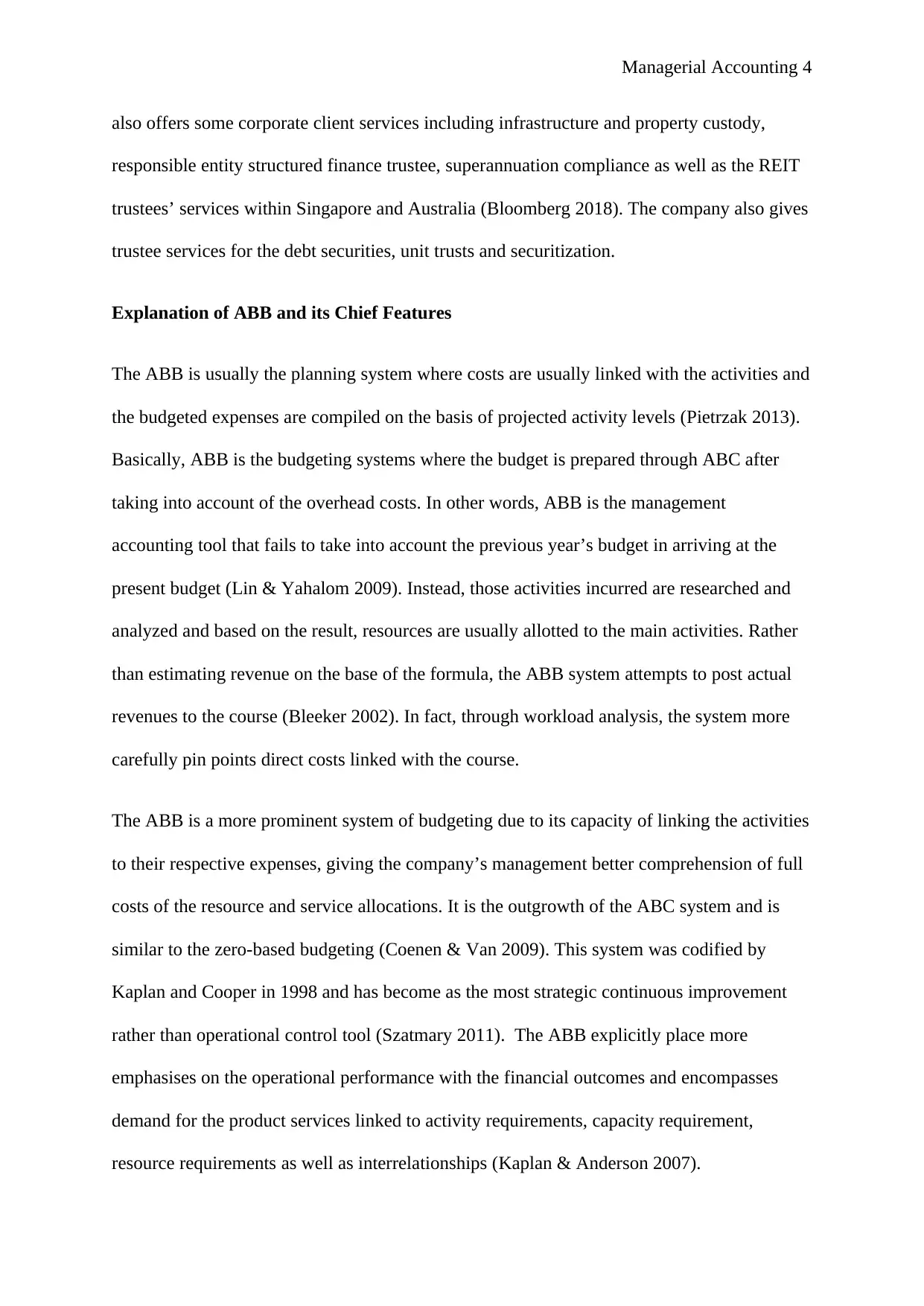
Managerial Accounting 4
also offers some corporate client services including infrastructure and property custody,
responsible entity structured finance trustee, superannuation compliance as well as the REIT
trustees’ services within Singapore and Australia (Bloomberg 2018). The company also gives
trustee services for the debt securities, unit trusts and securitization.
Explanation of ABB and its Chief Features
The ABB is usually the planning system where costs are usually linked with the activities and
the budgeted expenses are compiled on the basis of projected activity levels (Pietrzak 2013).
Basically, ABB is the budgeting systems where the budget is prepared through ABC after
taking into account of the overhead costs. In other words, ABB is the management
accounting tool that fails to take into account the previous year’s budget in arriving at the
present budget (Lin & Yahalom 2009). Instead, those activities incurred are researched and
analyzed and based on the result, resources are usually allotted to the main activities. Rather
than estimating revenue on the base of the formula, the ABB system attempts to post actual
revenues to the course (Bleeker 2002). In fact, through workload analysis, the system more
carefully pin points direct costs linked with the course.
The ABB is a more prominent system of budgeting due to its capacity of linking the activities
to their respective expenses, giving the company’s management better comprehension of full
costs of the resource and service allocations. It is the outgrowth of the ABC system and is
similar to the zero-based budgeting (Coenen & Van 2009). This system was codified by
Kaplan and Cooper in 1998 and has become as the most strategic continuous improvement
rather than operational control tool (Szatmary 2011). The ABB explicitly place more
emphasises on the operational performance with the financial outcomes and encompasses
demand for the product services linked to activity requirements, capacity requirement,
resource requirements as well as interrelationships (Kaplan & Anderson 2007).
also offers some corporate client services including infrastructure and property custody,
responsible entity structured finance trustee, superannuation compliance as well as the REIT
trustees’ services within Singapore and Australia (Bloomberg 2018). The company also gives
trustee services for the debt securities, unit trusts and securitization.
Explanation of ABB and its Chief Features
The ABB is usually the planning system where costs are usually linked with the activities and
the budgeted expenses are compiled on the basis of projected activity levels (Pietrzak 2013).
Basically, ABB is the budgeting systems where the budget is prepared through ABC after
taking into account of the overhead costs. In other words, ABB is the management
accounting tool that fails to take into account the previous year’s budget in arriving at the
present budget (Lin & Yahalom 2009). Instead, those activities incurred are researched and
analyzed and based on the result, resources are usually allotted to the main activities. Rather
than estimating revenue on the base of the formula, the ABB system attempts to post actual
revenues to the course (Bleeker 2002). In fact, through workload analysis, the system more
carefully pin points direct costs linked with the course.
The ABB is a more prominent system of budgeting due to its capacity of linking the activities
to their respective expenses, giving the company’s management better comprehension of full
costs of the resource and service allocations. It is the outgrowth of the ABC system and is
similar to the zero-based budgeting (Coenen & Van 2009). This system was codified by
Kaplan and Cooper in 1998 and has become as the most strategic continuous improvement
rather than operational control tool (Szatmary 2011). The ABB explicitly place more
emphasises on the operational performance with the financial outcomes and encompasses
demand for the product services linked to activity requirements, capacity requirement,
resource requirements as well as interrelationships (Kaplan & Anderson 2007).
Paraphrase This Document
Need a fresh take? Get an instant paraphrase of this document with our AI Paraphraser
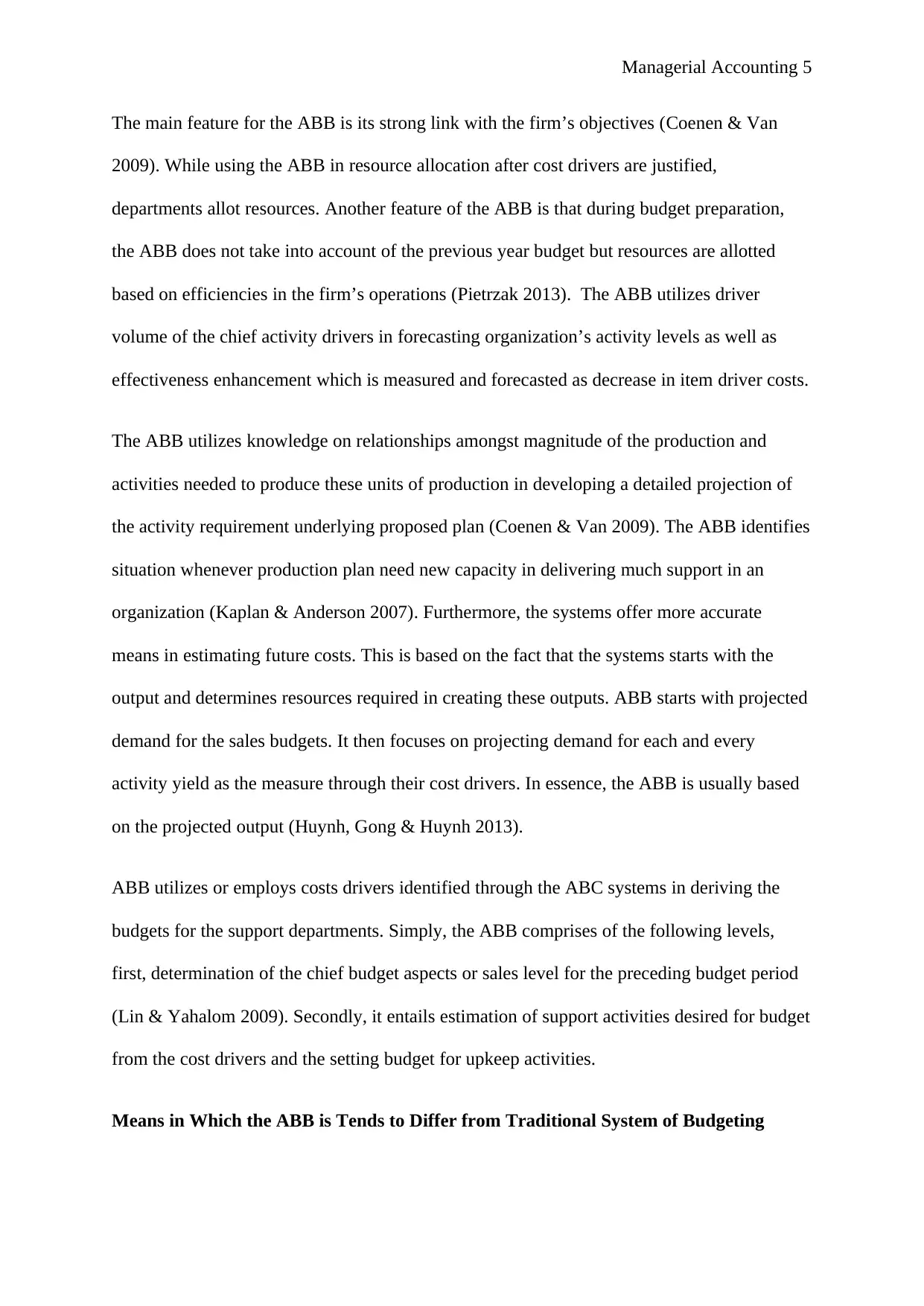
Managerial Accounting 5
The main feature for the ABB is its strong link with the firm’s objectives (Coenen & Van
2009). While using the ABB in resource allocation after cost drivers are justified,
departments allot resources. Another feature of the ABB is that during budget preparation,
the ABB does not take into account of the previous year budget but resources are allotted
based on efficiencies in the firm’s operations (Pietrzak 2013). The ABB utilizes driver
volume of the chief activity drivers in forecasting organization’s activity levels as well as
effectiveness enhancement which is measured and forecasted as decrease in item driver costs.
The ABB utilizes knowledge on relationships amongst magnitude of the production and
activities needed to produce these units of production in developing a detailed projection of
the activity requirement underlying proposed plan (Coenen & Van 2009). The ABB identifies
situation whenever production plan need new capacity in delivering much support in an
organization (Kaplan & Anderson 2007). Furthermore, the systems offer more accurate
means in estimating future costs. This is based on the fact that the systems starts with the
output and determines resources required in creating these outputs. ABB starts with projected
demand for the sales budgets. It then focuses on projecting demand for each and every
activity yield as the measure through their cost drivers. In essence, the ABB is usually based
on the projected output (Huynh, Gong & Huynh 2013).
ABB utilizes or employs costs drivers identified through the ABC systems in deriving the
budgets for the support departments. Simply, the ABB comprises of the following levels,
first, determination of the chief budget aspects or sales level for the preceding budget period
(Lin & Yahalom 2009). Secondly, it entails estimation of support activities desired for budget
from the cost drivers and the setting budget for upkeep activities.
Means in Which the ABB is Tends to Differ from Traditional System of Budgeting
The main feature for the ABB is its strong link with the firm’s objectives (Coenen & Van
2009). While using the ABB in resource allocation after cost drivers are justified,
departments allot resources. Another feature of the ABB is that during budget preparation,
the ABB does not take into account of the previous year budget but resources are allotted
based on efficiencies in the firm’s operations (Pietrzak 2013). The ABB utilizes driver
volume of the chief activity drivers in forecasting organization’s activity levels as well as
effectiveness enhancement which is measured and forecasted as decrease in item driver costs.
The ABB utilizes knowledge on relationships amongst magnitude of the production and
activities needed to produce these units of production in developing a detailed projection of
the activity requirement underlying proposed plan (Coenen & Van 2009). The ABB identifies
situation whenever production plan need new capacity in delivering much support in an
organization (Kaplan & Anderson 2007). Furthermore, the systems offer more accurate
means in estimating future costs. This is based on the fact that the systems starts with the
output and determines resources required in creating these outputs. ABB starts with projected
demand for the sales budgets. It then focuses on projecting demand for each and every
activity yield as the measure through their cost drivers. In essence, the ABB is usually based
on the projected output (Huynh, Gong & Huynh 2013).
ABB utilizes or employs costs drivers identified through the ABC systems in deriving the
budgets for the support departments. Simply, the ABB comprises of the following levels,
first, determination of the chief budget aspects or sales level for the preceding budget period
(Lin & Yahalom 2009). Secondly, it entails estimation of support activities desired for budget
from the cost drivers and the setting budget for upkeep activities.
Means in Which the ABB is Tends to Differ from Traditional System of Budgeting
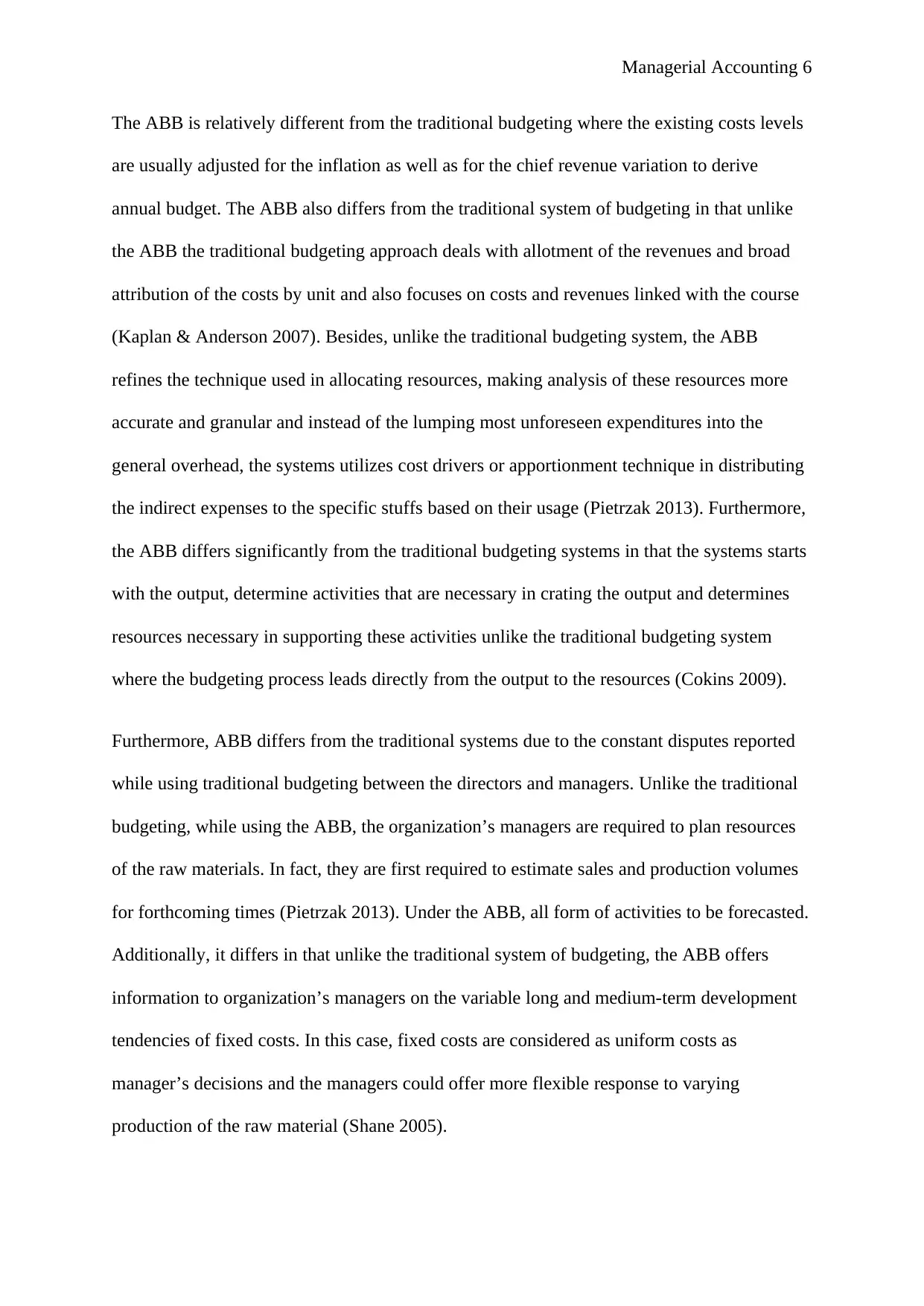
Managerial Accounting 6
The ABB is relatively different from the traditional budgeting where the existing costs levels
are usually adjusted for the inflation as well as for the chief revenue variation to derive
annual budget. The ABB also differs from the traditional system of budgeting in that unlike
the ABB the traditional budgeting approach deals with allotment of the revenues and broad
attribution of the costs by unit and also focuses on costs and revenues linked with the course
(Kaplan & Anderson 2007). Besides, unlike the traditional budgeting system, the ABB
refines the technique used in allocating resources, making analysis of these resources more
accurate and granular and instead of the lumping most unforeseen expenditures into the
general overhead, the systems utilizes cost drivers or apportionment technique in distributing
the indirect expenses to the specific stuffs based on their usage (Pietrzak 2013). Furthermore,
the ABB differs significantly from the traditional budgeting systems in that the systems starts
with the output, determine activities that are necessary in crating the output and determines
resources necessary in supporting these activities unlike the traditional budgeting system
where the budgeting process leads directly from the output to the resources (Cokins 2009).
Furthermore, ABB differs from the traditional systems due to the constant disputes reported
while using traditional budgeting between the directors and managers. Unlike the traditional
budgeting, while using the ABB, the organization’s managers are required to plan resources
of the raw materials. In fact, they are first required to estimate sales and production volumes
for forthcoming times (Pietrzak 2013). Under the ABB, all form of activities to be forecasted.
Additionally, it differs in that unlike the traditional system of budgeting, the ABB offers
information to organization’s managers on the variable long and medium-term development
tendencies of fixed costs. In this case, fixed costs are considered as uniform costs as
manager’s decisions and the managers could offer more flexible response to varying
production of the raw material (Shane 2005).
The ABB is relatively different from the traditional budgeting where the existing costs levels
are usually adjusted for the inflation as well as for the chief revenue variation to derive
annual budget. The ABB also differs from the traditional system of budgeting in that unlike
the ABB the traditional budgeting approach deals with allotment of the revenues and broad
attribution of the costs by unit and also focuses on costs and revenues linked with the course
(Kaplan & Anderson 2007). Besides, unlike the traditional budgeting system, the ABB
refines the technique used in allocating resources, making analysis of these resources more
accurate and granular and instead of the lumping most unforeseen expenditures into the
general overhead, the systems utilizes cost drivers or apportionment technique in distributing
the indirect expenses to the specific stuffs based on their usage (Pietrzak 2013). Furthermore,
the ABB differs significantly from the traditional budgeting systems in that the systems starts
with the output, determine activities that are necessary in crating the output and determines
resources necessary in supporting these activities unlike the traditional budgeting system
where the budgeting process leads directly from the output to the resources (Cokins 2009).
Furthermore, ABB differs from the traditional systems due to the constant disputes reported
while using traditional budgeting between the directors and managers. Unlike the traditional
budgeting, while using the ABB, the organization’s managers are required to plan resources
of the raw materials. In fact, they are first required to estimate sales and production volumes
for forthcoming times (Pietrzak 2013). Under the ABB, all form of activities to be forecasted.
Additionally, it differs in that unlike the traditional system of budgeting, the ABB offers
information to organization’s managers on the variable long and medium-term development
tendencies of fixed costs. In this case, fixed costs are considered as uniform costs as
manager’s decisions and the managers could offer more flexible response to varying
production of the raw material (Shane 2005).
⊘ This is a preview!⊘
Do you want full access?
Subscribe today to unlock all pages.

Trusted by 1+ million students worldwide
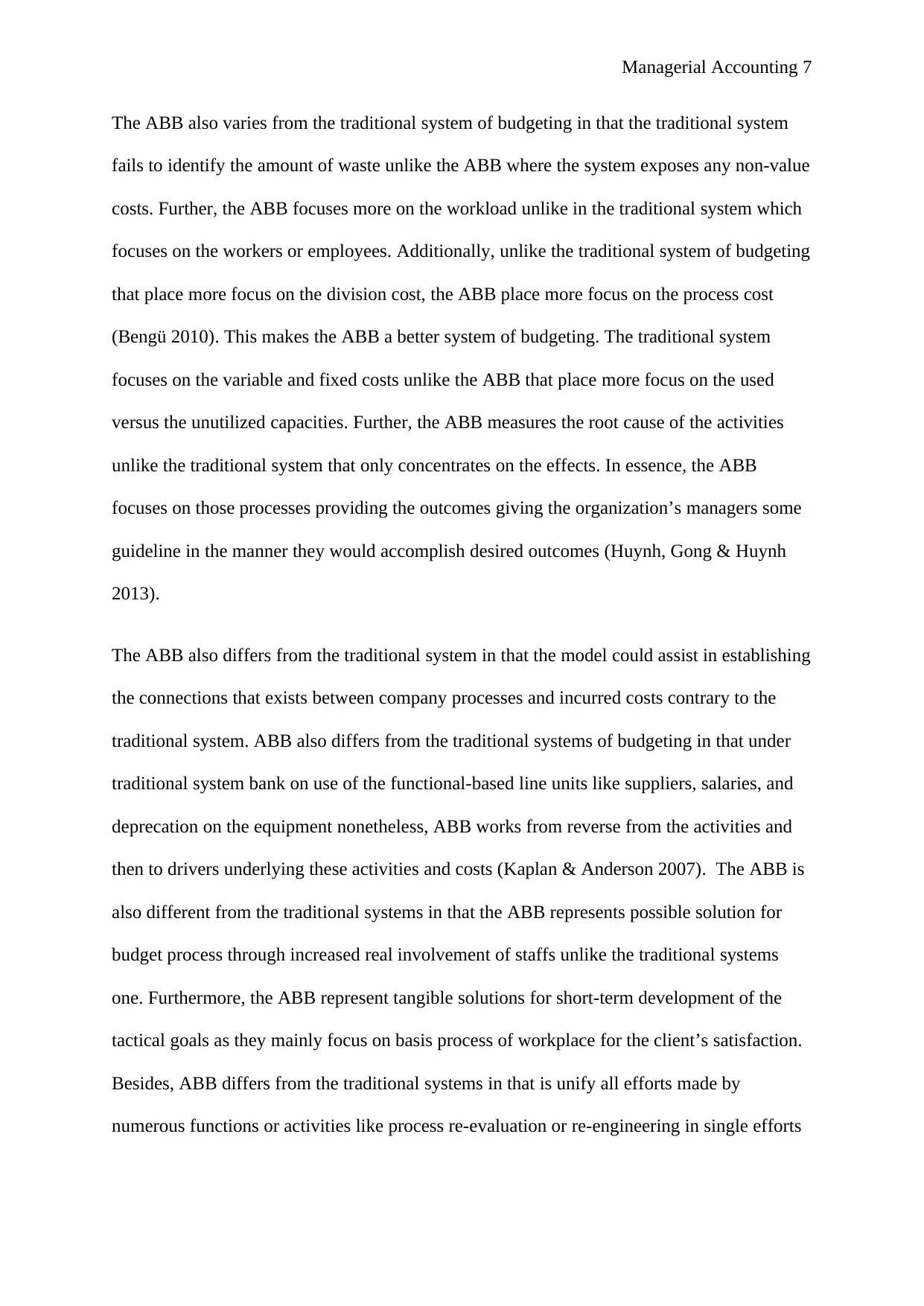
Managerial Accounting 7
The ABB also varies from the traditional system of budgeting in that the traditional system
fails to identify the amount of waste unlike the ABB where the system exposes any non-value
costs. Further, the ABB focuses more on the workload unlike in the traditional system which
focuses on the workers or employees. Additionally, unlike the traditional system of budgeting
that place more focus on the division cost, the ABB place more focus on the process cost
(Bengü 2010). This makes the ABB a better system of budgeting. The traditional system
focuses on the variable and fixed costs unlike the ABB that place more focus on the used
versus the unutilized capacities. Further, the ABB measures the root cause of the activities
unlike the traditional system that only concentrates on the effects. In essence, the ABB
focuses on those processes providing the outcomes giving the organization’s managers some
guideline in the manner they would accomplish desired outcomes (Huynh, Gong & Huynh
2013).
The ABB also differs from the traditional system in that the model could assist in establishing
the connections that exists between company processes and incurred costs contrary to the
traditional system. ABB also differs from the traditional systems of budgeting in that under
traditional system bank on use of the functional-based line units like suppliers, salaries, and
deprecation on the equipment nonetheless, ABB works from reverse from the activities and
then to drivers underlying these activities and costs (Kaplan & Anderson 2007). The ABB is
also different from the traditional systems in that the ABB represents possible solution for
budget process through increased real involvement of staffs unlike the traditional systems
one. Furthermore, the ABB represent tangible solutions for short-term development of the
tactical goals as they mainly focus on basis process of workplace for the client’s satisfaction.
Besides, ABB differs from the traditional systems in that is unify all efforts made by
numerous functions or activities like process re-evaluation or re-engineering in single efforts
The ABB also varies from the traditional system of budgeting in that the traditional system
fails to identify the amount of waste unlike the ABB where the system exposes any non-value
costs. Further, the ABB focuses more on the workload unlike in the traditional system which
focuses on the workers or employees. Additionally, unlike the traditional system of budgeting
that place more focus on the division cost, the ABB place more focus on the process cost
(Bengü 2010). This makes the ABB a better system of budgeting. The traditional system
focuses on the variable and fixed costs unlike the ABB that place more focus on the used
versus the unutilized capacities. Further, the ABB measures the root cause of the activities
unlike the traditional system that only concentrates on the effects. In essence, the ABB
focuses on those processes providing the outcomes giving the organization’s managers some
guideline in the manner they would accomplish desired outcomes (Huynh, Gong & Huynh
2013).
The ABB also differs from the traditional system in that the model could assist in establishing
the connections that exists between company processes and incurred costs contrary to the
traditional system. ABB also differs from the traditional systems of budgeting in that under
traditional system bank on use of the functional-based line units like suppliers, salaries, and
deprecation on the equipment nonetheless, ABB works from reverse from the activities and
then to drivers underlying these activities and costs (Kaplan & Anderson 2007). The ABB is
also different from the traditional systems in that the ABB represents possible solution for
budget process through increased real involvement of staffs unlike the traditional systems
one. Furthermore, the ABB represent tangible solutions for short-term development of the
tactical goals as they mainly focus on basis process of workplace for the client’s satisfaction.
Besides, ABB differs from the traditional systems in that is unify all efforts made by
numerous functions or activities like process re-evaluation or re-engineering in single efforts
Paraphrase This Document
Need a fresh take? Get an instant paraphrase of this document with our AI Paraphraser
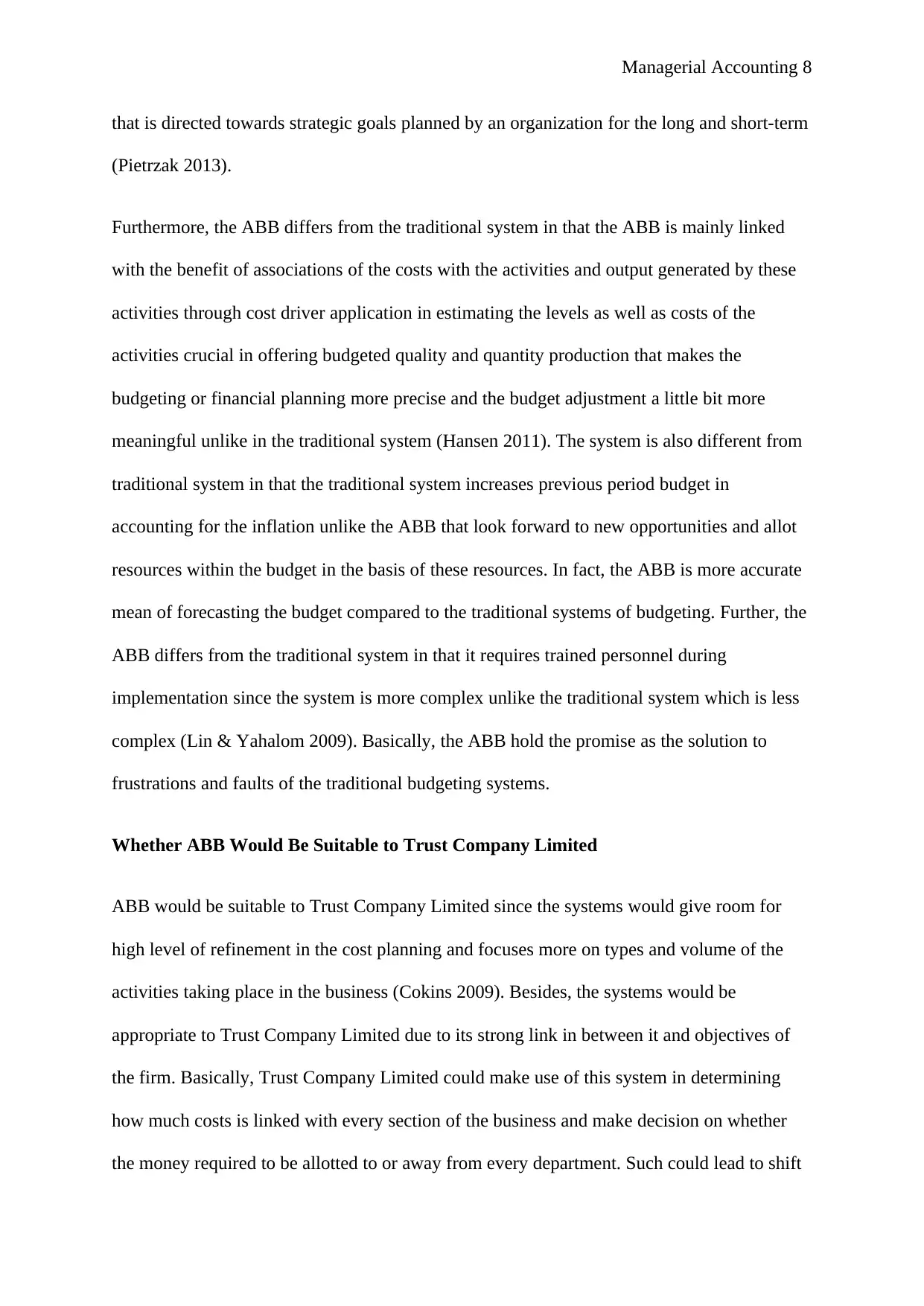
Managerial Accounting 8
that is directed towards strategic goals planned by an organization for the long and short-term
(Pietrzak 2013).
Furthermore, the ABB differs from the traditional system in that the ABB is mainly linked
with the benefit of associations of the costs with the activities and output generated by these
activities through cost driver application in estimating the levels as well as costs of the
activities crucial in offering budgeted quality and quantity production that makes the
budgeting or financial planning more precise and the budget adjustment a little bit more
meaningful unlike in the traditional system (Hansen 2011). The system is also different from
traditional system in that the traditional system increases previous period budget in
accounting for the inflation unlike the ABB that look forward to new opportunities and allot
resources within the budget in the basis of these resources. In fact, the ABB is more accurate
mean of forecasting the budget compared to the traditional systems of budgeting. Further, the
ABB differs from the traditional system in that it requires trained personnel during
implementation since the system is more complex unlike the traditional system which is less
complex (Lin & Yahalom 2009). Basically, the ABB hold the promise as the solution to
frustrations and faults of the traditional budgeting systems.
Whether ABB Would Be Suitable to Trust Company Limited
ABB would be suitable to Trust Company Limited since the systems would give room for
high level of refinement in the cost planning and focuses more on types and volume of the
activities taking place in the business (Cokins 2009). Besides, the systems would be
appropriate to Trust Company Limited due to its strong link in between it and objectives of
the firm. Basically, Trust Company Limited could make use of this system in determining
how much costs is linked with every section of the business and make decision on whether
the money required to be allotted to or away from every department. Such could lead to shift
that is directed towards strategic goals planned by an organization for the long and short-term
(Pietrzak 2013).
Furthermore, the ABB differs from the traditional system in that the ABB is mainly linked
with the benefit of associations of the costs with the activities and output generated by these
activities through cost driver application in estimating the levels as well as costs of the
activities crucial in offering budgeted quality and quantity production that makes the
budgeting or financial planning more precise and the budget adjustment a little bit more
meaningful unlike in the traditional system (Hansen 2011). The system is also different from
traditional system in that the traditional system increases previous period budget in
accounting for the inflation unlike the ABB that look forward to new opportunities and allot
resources within the budget in the basis of these resources. In fact, the ABB is more accurate
mean of forecasting the budget compared to the traditional systems of budgeting. Further, the
ABB differs from the traditional system in that it requires trained personnel during
implementation since the system is more complex unlike the traditional system which is less
complex (Lin & Yahalom 2009). Basically, the ABB hold the promise as the solution to
frustrations and faults of the traditional budgeting systems.
Whether ABB Would Be Suitable to Trust Company Limited
ABB would be suitable to Trust Company Limited since the systems would give room for
high level of refinement in the cost planning and focuses more on types and volume of the
activities taking place in the business (Cokins 2009). Besides, the systems would be
appropriate to Trust Company Limited due to its strong link in between it and objectives of
the firm. Basically, Trust Company Limited could make use of this system in determining
how much costs is linked with every section of the business and make decision on whether
the money required to be allotted to or away from every department. Such could lead to shift
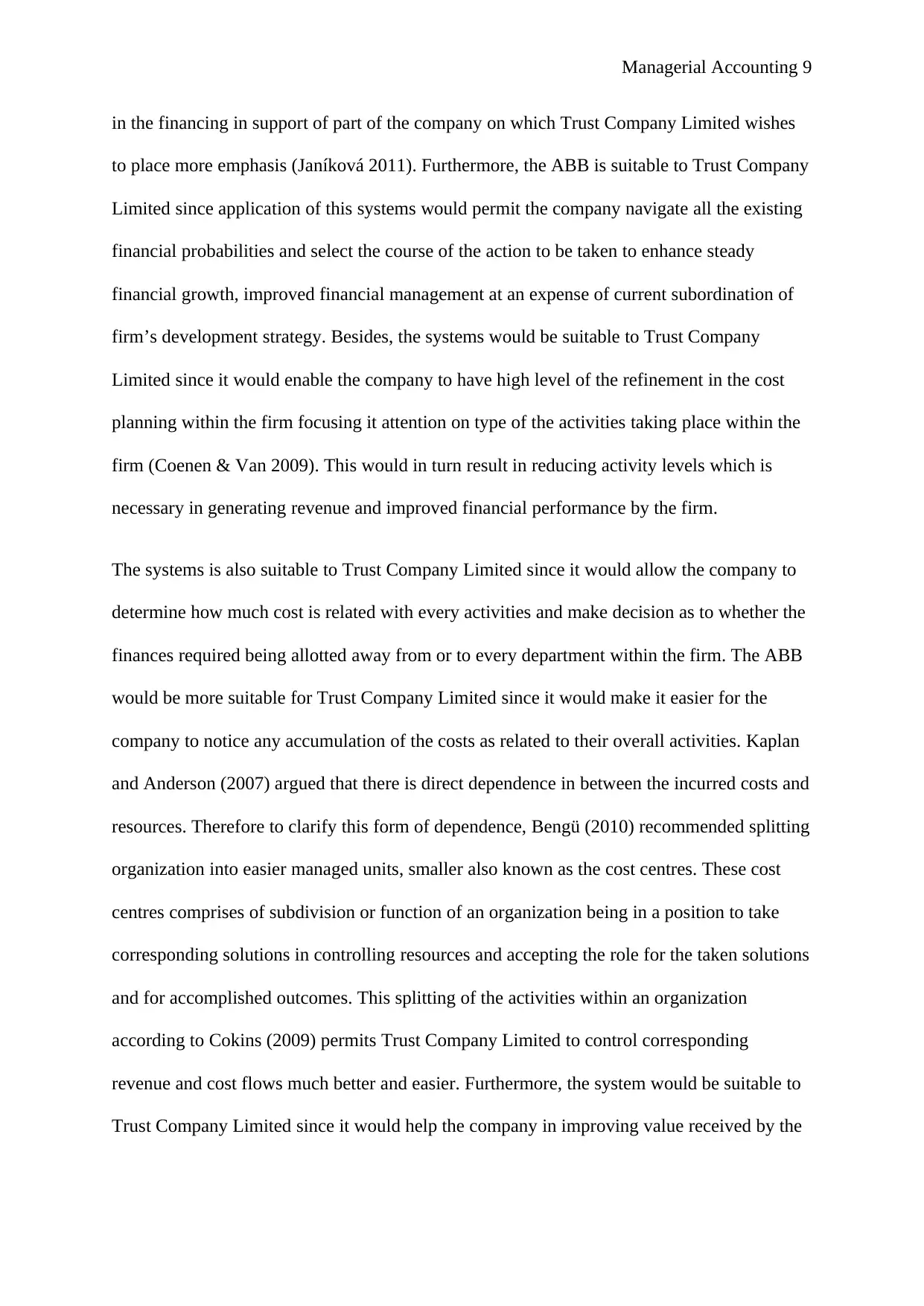
Managerial Accounting 9
in the financing in support of part of the company on which Trust Company Limited wishes
to place more emphasis (Janíková 2011). Furthermore, the ABB is suitable to Trust Company
Limited since application of this systems would permit the company navigate all the existing
financial probabilities and select the course of the action to be taken to enhance steady
financial growth, improved financial management at an expense of current subordination of
firm’s development strategy. Besides, the systems would be suitable to Trust Company
Limited since it would enable the company to have high level of the refinement in the cost
planning within the firm focusing it attention on type of the activities taking place within the
firm (Coenen & Van 2009). This would in turn result in reducing activity levels which is
necessary in generating revenue and improved financial performance by the firm.
The systems is also suitable to Trust Company Limited since it would allow the company to
determine how much cost is related with every activities and make decision as to whether the
finances required being allotted away from or to every department within the firm. The ABB
would be more suitable for Trust Company Limited since it would make it easier for the
company to notice any accumulation of the costs as related to their overall activities. Kaplan
and Anderson (2007) argued that there is direct dependence in between the incurred costs and
resources. Therefore to clarify this form of dependence, Bengü (2010) recommended splitting
organization into easier managed units, smaller also known as the cost centres. These cost
centres comprises of subdivision or function of an organization being in a position to take
corresponding solutions in controlling resources and accepting the role for the taken solutions
and for accomplished outcomes. This splitting of the activities within an organization
according to Cokins (2009) permits Trust Company Limited to control corresponding
revenue and cost flows much better and easier. Furthermore, the system would be suitable to
Trust Company Limited since it would help the company in improving value received by the
in the financing in support of part of the company on which Trust Company Limited wishes
to place more emphasis (Janíková 2011). Furthermore, the ABB is suitable to Trust Company
Limited since application of this systems would permit the company navigate all the existing
financial probabilities and select the course of the action to be taken to enhance steady
financial growth, improved financial management at an expense of current subordination of
firm’s development strategy. Besides, the systems would be suitable to Trust Company
Limited since it would enable the company to have high level of the refinement in the cost
planning within the firm focusing it attention on type of the activities taking place within the
firm (Coenen & Van 2009). This would in turn result in reducing activity levels which is
necessary in generating revenue and improved financial performance by the firm.
The systems is also suitable to Trust Company Limited since it would allow the company to
determine how much cost is related with every activities and make decision as to whether the
finances required being allotted away from or to every department within the firm. The ABB
would be more suitable for Trust Company Limited since it would make it easier for the
company to notice any accumulation of the costs as related to their overall activities. Kaplan
and Anderson (2007) argued that there is direct dependence in between the incurred costs and
resources. Therefore to clarify this form of dependence, Bengü (2010) recommended splitting
organization into easier managed units, smaller also known as the cost centres. These cost
centres comprises of subdivision or function of an organization being in a position to take
corresponding solutions in controlling resources and accepting the role for the taken solutions
and for accomplished outcomes. This splitting of the activities within an organization
according to Cokins (2009) permits Trust Company Limited to control corresponding
revenue and cost flows much better and easier. Furthermore, the system would be suitable to
Trust Company Limited since it would help the company in improving value received by the
⊘ This is a preview!⊘
Do you want full access?
Subscribe today to unlock all pages.

Trusted by 1+ million students worldwide
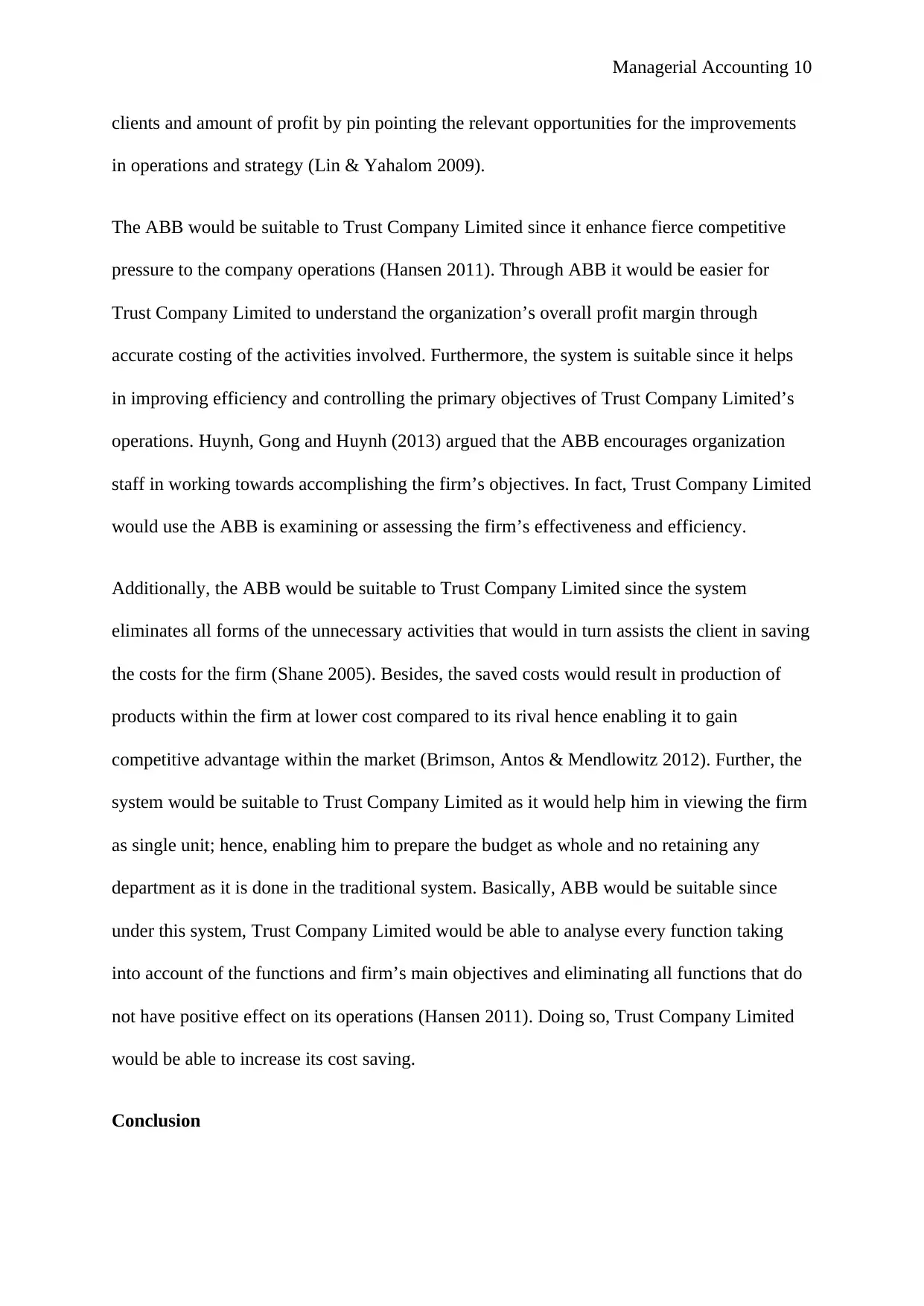
Managerial Accounting 10
clients and amount of profit by pin pointing the relevant opportunities for the improvements
in operations and strategy (Lin & Yahalom 2009).
The ABB would be suitable to Trust Company Limited since it enhance fierce competitive
pressure to the company operations (Hansen 2011). Through ABB it would be easier for
Trust Company Limited to understand the organization’s overall profit margin through
accurate costing of the activities involved. Furthermore, the system is suitable since it helps
in improving efficiency and controlling the primary objectives of Trust Company Limited’s
operations. Huynh, Gong and Huynh (2013) argued that the ABB encourages organization
staff in working towards accomplishing the firm’s objectives. In fact, Trust Company Limited
would use the ABB is examining or assessing the firm’s effectiveness and efficiency.
Additionally, the ABB would be suitable to Trust Company Limited since the system
eliminates all forms of the unnecessary activities that would in turn assists the client in saving
the costs for the firm (Shane 2005). Besides, the saved costs would result in production of
products within the firm at lower cost compared to its rival hence enabling it to gain
competitive advantage within the market (Brimson, Antos & Mendlowitz 2012). Further, the
system would be suitable to Trust Company Limited as it would help him in viewing the firm
as single unit; hence, enabling him to prepare the budget as whole and no retaining any
department as it is done in the traditional system. Basically, ABB would be suitable since
under this system, Trust Company Limited would be able to analyse every function taking
into account of the functions and firm’s main objectives and eliminating all functions that do
not have positive effect on its operations (Hansen 2011). Doing so, Trust Company Limited
would be able to increase its cost saving.
Conclusion
clients and amount of profit by pin pointing the relevant opportunities for the improvements
in operations and strategy (Lin & Yahalom 2009).
The ABB would be suitable to Trust Company Limited since it enhance fierce competitive
pressure to the company operations (Hansen 2011). Through ABB it would be easier for
Trust Company Limited to understand the organization’s overall profit margin through
accurate costing of the activities involved. Furthermore, the system is suitable since it helps
in improving efficiency and controlling the primary objectives of Trust Company Limited’s
operations. Huynh, Gong and Huynh (2013) argued that the ABB encourages organization
staff in working towards accomplishing the firm’s objectives. In fact, Trust Company Limited
would use the ABB is examining or assessing the firm’s effectiveness and efficiency.
Additionally, the ABB would be suitable to Trust Company Limited since the system
eliminates all forms of the unnecessary activities that would in turn assists the client in saving
the costs for the firm (Shane 2005). Besides, the saved costs would result in production of
products within the firm at lower cost compared to its rival hence enabling it to gain
competitive advantage within the market (Brimson, Antos & Mendlowitz 2012). Further, the
system would be suitable to Trust Company Limited as it would help him in viewing the firm
as single unit; hence, enabling him to prepare the budget as whole and no retaining any
department as it is done in the traditional system. Basically, ABB would be suitable since
under this system, Trust Company Limited would be able to analyse every function taking
into account of the functions and firm’s main objectives and eliminating all functions that do
not have positive effect on its operations (Hansen 2011). Doing so, Trust Company Limited
would be able to increase its cost saving.
Conclusion
Paraphrase This Document
Need a fresh take? Get an instant paraphrase of this document with our AI Paraphraser
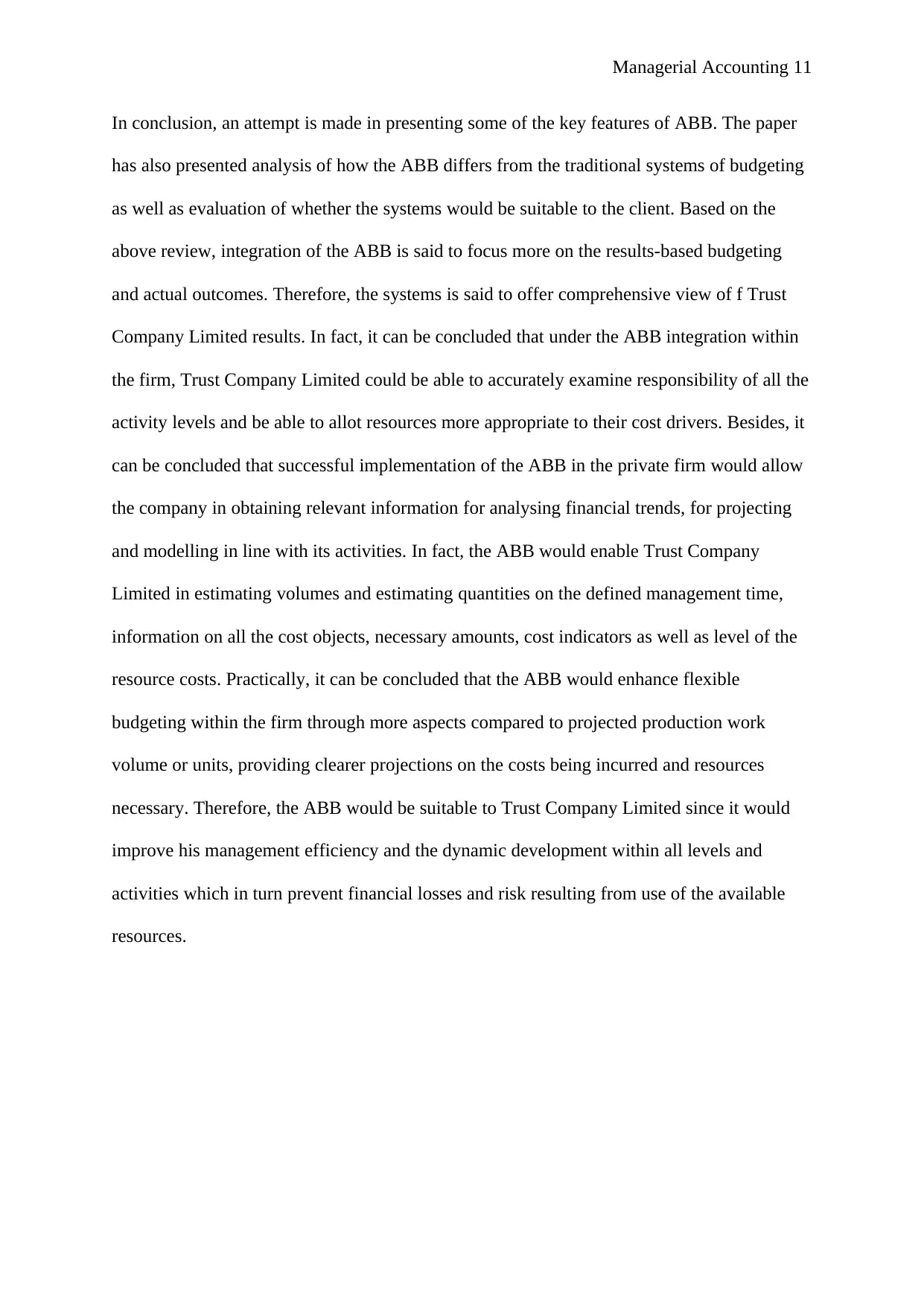
Managerial Accounting 11
In conclusion, an attempt is made in presenting some of the key features of ABB. The paper
has also presented analysis of how the ABB differs from the traditional systems of budgeting
as well as evaluation of whether the systems would be suitable to the client. Based on the
above review, integration of the ABB is said to focus more on the results-based budgeting
and actual outcomes. Therefore, the systems is said to offer comprehensive view of f Trust
Company Limited results. In fact, it can be concluded that under the ABB integration within
the firm, Trust Company Limited could be able to accurately examine responsibility of all the
activity levels and be able to allot resources more appropriate to their cost drivers. Besides, it
can be concluded that successful implementation of the ABB in the private firm would allow
the company in obtaining relevant information for analysing financial trends, for projecting
and modelling in line with its activities. In fact, the ABB would enable Trust Company
Limited in estimating volumes and estimating quantities on the defined management time,
information on all the cost objects, necessary amounts, cost indicators as well as level of the
resource costs. Practically, it can be concluded that the ABB would enhance flexible
budgeting within the firm through more aspects compared to projected production work
volume or units, providing clearer projections on the costs being incurred and resources
necessary. Therefore, the ABB would be suitable to Trust Company Limited since it would
improve his management efficiency and the dynamic development within all levels and
activities which in turn prevent financial losses and risk resulting from use of the available
resources.
In conclusion, an attempt is made in presenting some of the key features of ABB. The paper
has also presented analysis of how the ABB differs from the traditional systems of budgeting
as well as evaluation of whether the systems would be suitable to the client. Based on the
above review, integration of the ABB is said to focus more on the results-based budgeting
and actual outcomes. Therefore, the systems is said to offer comprehensive view of f Trust
Company Limited results. In fact, it can be concluded that under the ABB integration within
the firm, Trust Company Limited could be able to accurately examine responsibility of all the
activity levels and be able to allot resources more appropriate to their cost drivers. Besides, it
can be concluded that successful implementation of the ABB in the private firm would allow
the company in obtaining relevant information for analysing financial trends, for projecting
and modelling in line with its activities. In fact, the ABB would enable Trust Company
Limited in estimating volumes and estimating quantities on the defined management time,
information on all the cost objects, necessary amounts, cost indicators as well as level of the
resource costs. Practically, it can be concluded that the ABB would enhance flexible
budgeting within the firm through more aspects compared to projected production work
volume or units, providing clearer projections on the costs being incurred and resources
necessary. Therefore, the ABB would be suitable to Trust Company Limited since it would
improve his management efficiency and the dynamic development within all levels and
activities which in turn prevent financial losses and risk resulting from use of the available
resources.
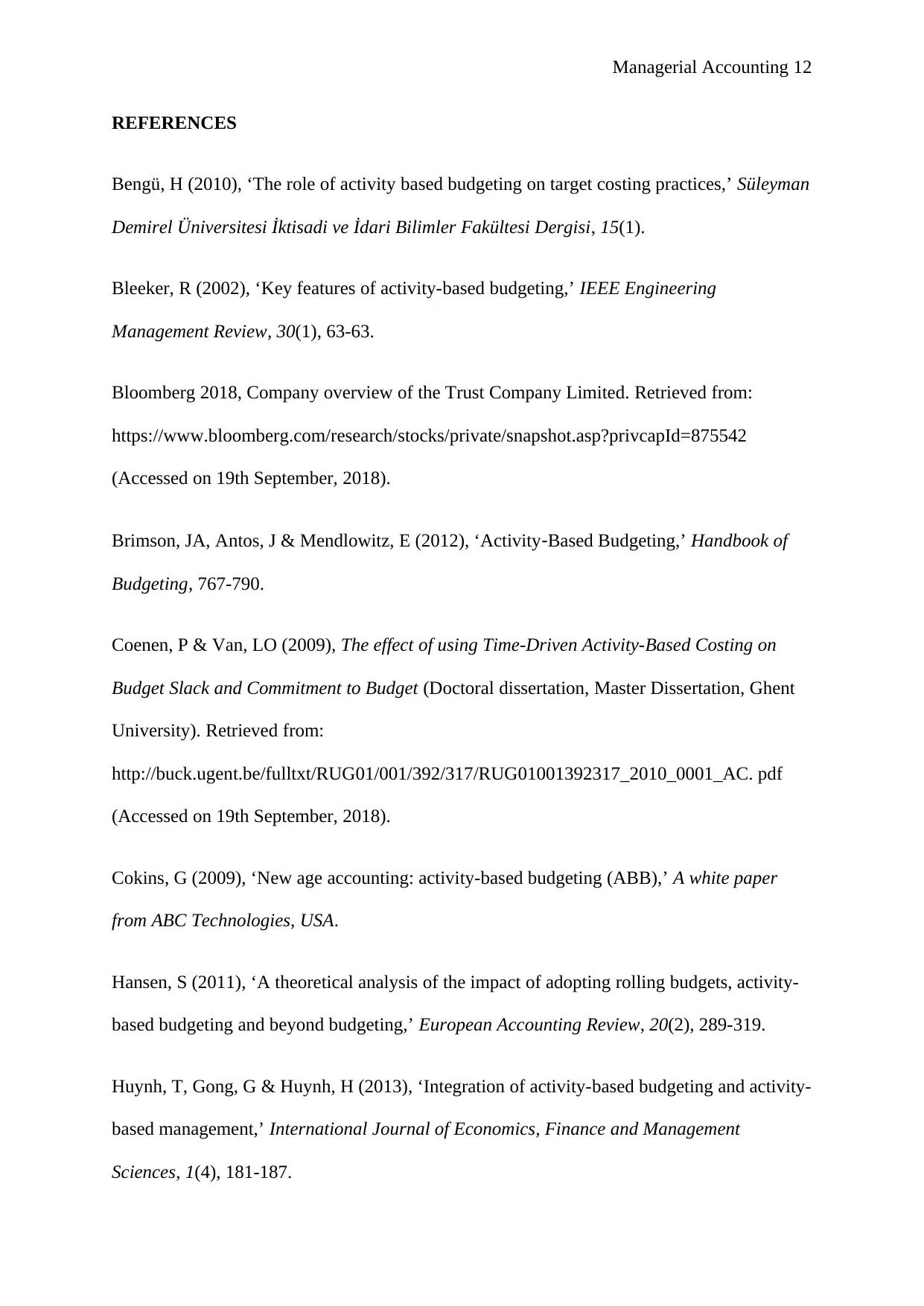
Managerial Accounting 12
REFERENCES
Bengü, H (2010), ‘The role of activity based budgeting on target costing practices,’ Süleyman
Demirel Üniversitesi İktisadi ve İdari Bilimler Fakültesi Dergisi, 15(1).
Bleeker, R (2002), ‘Key features of activity-based budgeting,’ IEEE Engineering
Management Review, 30(1), 63-63.
Bloomberg 2018, Company overview of the Trust Company Limited. Retrieved from:
https://www.bloomberg.com/research/stocks/private/snapshot.asp?privcapId=875542
(Accessed on 19th September, 2018).
Brimson, JA, Antos, J & Mendlowitz, E (2012), ‘Activity‐Based Budgeting,’ Handbook of
Budgeting, 767-790.
Coenen, P & Van, LO (2009), The effect of using Time-Driven Activity-Based Costing on
Budget Slack and Commitment to Budget (Doctoral dissertation, Master Dissertation, Ghent
University). Retrieved from:
http://buck.ugent.be/fulltxt/RUG01/001/392/317/RUG01001392317_2010_0001_AC. pdf
(Accessed on 19th September, 2018).
Cokins, G (2009), ‘New age accounting: activity-based budgeting (ABB),’ A white paper
from ABC Technologies, USA.
Hansen, S (2011), ‘A theoretical analysis of the impact of adopting rolling budgets, activity-
based budgeting and beyond budgeting,’ European Accounting Review, 20(2), 289-319.
Huynh, T, Gong, G & Huynh, H (2013), ‘Integration of activity-based budgeting and activity-
based management,’ International Journal of Economics, Finance and Management
Sciences, 1(4), 181-187.
REFERENCES
Bengü, H (2010), ‘The role of activity based budgeting on target costing practices,’ Süleyman
Demirel Üniversitesi İktisadi ve İdari Bilimler Fakültesi Dergisi, 15(1).
Bleeker, R (2002), ‘Key features of activity-based budgeting,’ IEEE Engineering
Management Review, 30(1), 63-63.
Bloomberg 2018, Company overview of the Trust Company Limited. Retrieved from:
https://www.bloomberg.com/research/stocks/private/snapshot.asp?privcapId=875542
(Accessed on 19th September, 2018).
Brimson, JA, Antos, J & Mendlowitz, E (2012), ‘Activity‐Based Budgeting,’ Handbook of
Budgeting, 767-790.
Coenen, P & Van, LO (2009), The effect of using Time-Driven Activity-Based Costing on
Budget Slack and Commitment to Budget (Doctoral dissertation, Master Dissertation, Ghent
University). Retrieved from:
http://buck.ugent.be/fulltxt/RUG01/001/392/317/RUG01001392317_2010_0001_AC. pdf
(Accessed on 19th September, 2018).
Cokins, G (2009), ‘New age accounting: activity-based budgeting (ABB),’ A white paper
from ABC Technologies, USA.
Hansen, S (2011), ‘A theoretical analysis of the impact of adopting rolling budgets, activity-
based budgeting and beyond budgeting,’ European Accounting Review, 20(2), 289-319.
Huynh, T, Gong, G & Huynh, H (2013), ‘Integration of activity-based budgeting and activity-
based management,’ International Journal of Economics, Finance and Management
Sciences, 1(4), 181-187.
⊘ This is a preview!⊘
Do you want full access?
Subscribe today to unlock all pages.

Trusted by 1+ million students worldwide
1 out of 13
Related Documents
Your All-in-One AI-Powered Toolkit for Academic Success.
+13062052269
info@desklib.com
Available 24*7 on WhatsApp / Email
![[object Object]](/_next/static/media/star-bottom.7253800d.svg)
Unlock your academic potential
Copyright © 2020–2025 A2Z Services. All Rights Reserved. Developed and managed by ZUCOL.





